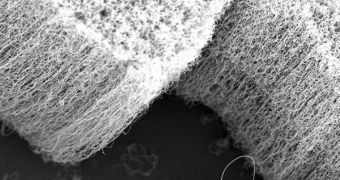Stacking DNA and carbon nanotubes onto a biosensor electrode could lead to the development of more advanced, high-precision devices capable of accurately measuring indicators left behind in the human body by conditions such as diabetes
The team of investigators – which is based at the Purdue University – says that the new approach could help advanced international research on numerous conditions affecting millions of people today.
At this point, a large portion of the imperfect, less-accurate measurements researchers have to work with is due to the fact that sensors are made out of metal. They are coated with enzymes that are able to produce an electrical signal when they are activated, but this is insufficient for precise results.
For quite some time now, experts have been suggesting that carbon nanotubes might improve these performances, but introducing the molecules into standard use has proven difficult due to the fact that they do not get along with water.
This made them unsuited for applications involving biological fluids, researchers say. However, by adding DNA sequences that are complementary to the CNT, it is possible to make the nanotubes function properly in liquids as well.
The achievement was reached by a team of investigators at Purdue, which was led by Marshall Porterfield and Jong Hyun Choi. Details of their accomplishment appear in the latest issue of the journal The Analyst.
Porterfield holds an appointment as a professor of agricultural and biological engineering and biomedical engineering, while Choi is an assistant professor of mechanical engineering at the university.
“In the future, we will be able to create a DNA sequence that is complementary to the carbon nanotubes and is compatible with specific biosensor enzymes for the many different compounds we want to measure,” Porterfield explains.
“It will be a self-assembling platform for biosensors at the biomolecular level,” he goes on to say.
“Once the carbon nanotubes are in a solution, you only have to place the electrode into the solution and charge it. The carbon nanotubes will then coat the surface,” Choi adds. He was the one who developed the DNA molecules necessary for the CNT to work in fluids.
“You could mass produce these sensors for diabetes, for example, for insulin management for diabetic patients,” Porterfield says of the potential practical applications this innovation could have.
The study was sponsored by grants from the National Institutes of Health (NIH) and the Office of Naval Research (ONR).

 14 DAY TRIAL //
14 DAY TRIAL //